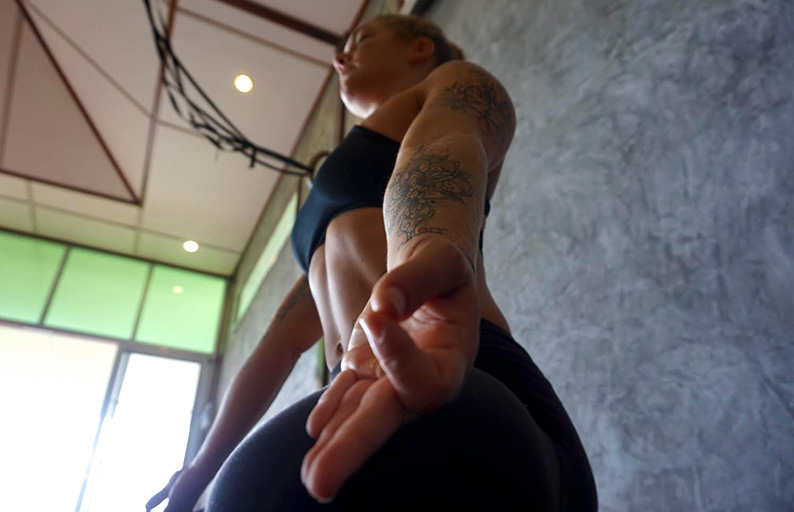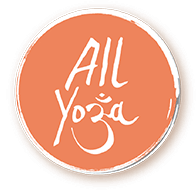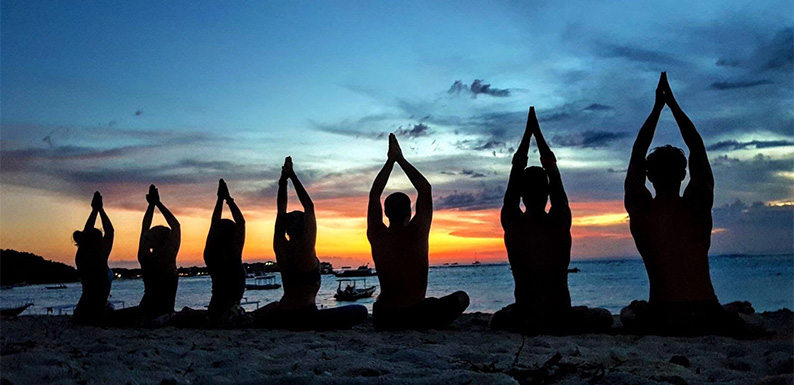Yoga Philosophy – What Are Yamas?
When thinking about yoga in the modern world we often consider the physical postures, or the asanas, that we practice on our mats. Yoga has many other aspects designed to help us unite our mind, body and spirit. The 8 limbs of yoga show us how to progress through life and along the yogic path. They consist of; the Yamas, the Niyamas, Asana, Pranayama, Pratyahara, Dharana, Dhyana, and Samadhi. But let us take a look at the first limb:
The Yamas are ethical and moral guidelines or observances given to us by the Indian sage Patanjali in the yogic philosophical text, the Yoga Sutras, over 5000 years ago. These disciplines aid us in becoming more self-aware and also guide us along and onto the other 8 limbs of yoga as discussed in the Sutras. This ancient knowledge and wisdom are prevalent even in today’s chaotic and modern world, which can help us find peace and unity. In this article, I would briefly go over the main parts of Yamas, and how we can understand and put them into practice in our daily lives.
Ahimsa – non-violence/ not causing pain
‘Himsa’ can be translated as ‘causing pain’. When turned into ‘A-himsa’ it means ‘not causing pain’. As human beings, we often cause pain in our daily lives if we stumble and forget to consider others when it comes to our words, our thoughts, and our emotions. Patanjali asked us to have deep-rooted compassion towards all living things. We are all connected, and when we hurt others, we are only hurting ourselves.
“Holding on to anger is like grasping a hot coal with the intent of throwing it at someone else; you are the one who gets burned.”
― Buddhaghosa
We also hurt ourselves with negative self-talk or when we compare ourselves to others unnecessarily, yet this is so easy to do. We might punish ourselves if we eat something that doesn’t fit into our ‘diet’ or maybe by over-exercising due to feeling guilt from eating ‘unhealthy food’. Other examples range from hating the way we look, how we handle situations in life, or how we unfairly perceive ourselves to be in society. There is a lot to consider when contemplating and applying Ahimsa into our daily lives. Some practitioners believe that one positive way of integrating Ahimsa is by becoming vegetarian or vegan. But if you make this vow, you may still not be completely free of violence.
As I said before, there is a lot to consider, and it’s incredibly effortless to take a position of judgement towards others. Another aspect to consider is watching violence and doing nothing about it since that, in turn, is a violent act. How many times do we decide to keep quiet rather than stand up for others? Sometimes in certain situations, we can justify the use of violence; however, this doesn’t mean it is always ok to do so. As human beings, we all need to take personal responsibility for our actions. Ahimsa asks us to look deeply at ourselves and helps to remind us to do the least amount of violence as possible whenever we can.

Satya – truthfulness
To include Satya in our daily lives is to be truthful in all that we do, and we all know what happened to Pinocchio when he told even the smallest of white lies. I remember being scolded by my mother as a child for passing on gossip about a friend. I didn’t understand then that gossip is harmful to others, which also goes against the previous Yama – Ahimsa. When we spread slander about others, we are causing hurt. But we can avoid this by being the one to break that chain.
You may have an ex or a friend that has caused you great upset. But by continuing to share gossip as gospel, we end up only hurting ourselves – the upset goes over and over again in our minds. It is so easy to get sucked into that negative and unhealthy cycle.
Telling the truth doesn’t always have to seem so righteous either. For example, if a friend or a colleague asks you whether you would like to go out for a few drinks and you don’t want to, be honest rather than turning around and agreeing, to then later cancel and therefore waste their time. Although on the flip side of this, we need to address how we tell the truth, as we can be hurt with it too. If we are about to share something, we first need to consider whether what we are going to say would cause someone else to lie; or whether we are saying that in a compassionate and not a selfish way?
“All nature loves an honest person. Then you will not need to run after things, for they will run after you. And if you are always truthful, if no lie comes from your mouth, a time will come when all you say will come true.”
― Sri Swami Satchidananda ― The Yoga Sutras of Patanjali
Today, it can be hard to sift through what is real with the boom of social media. Most of us tend to lean towards sharing a slight fabrication of the truth rather than showing our lives as they really are. But we are only humans, and would all like to slightly obscure our ‘bad bits’ from time to time. However, beware that you may be inadvertently harming others by portraying your life to be ‘better’ than it truly is. And maybe causing an unfair comparison of your lives and others’? Be honestly authentic and utterly genuine in your words and actions, as you will empower yourself and others with the truth.
Asteya – non-stealing
To steal is to take anything that has not been given freely to us and there are many things that we can ‘steal’ from others. Taking money and possessions seem like some the most visible acts of stealing. But we may also unconsciously steal. That friend you agreed to meet at a specific time, but you turned up half an hour late? You have stolen their time. That project one of your colleagues helped you on, but you took all the reward for it? You have stolen the credit from them. Again, we can tie the previous vow of Satya – truthfulness into this by understanding that: by telling a lie, we are stealing the truth.
We may steal in our relationships with others. Maybe you’ve, like me, had relationships in the past where you attracted all of your partner’s attention using your insecurities and lack of self-confidence. You may have stolen their time, effort, and distracted them from doing their things.
In our jobs, we can also steal. How many of us have dragged our heels at work so to speak or found a way to do less or get out of something that we don’t want to do? Again, we are humans. But by practising Asteya, we practice being fair to nature and those around us. By giving ourselves a moment to contemplate how we can give back rather than take from others, we help ourselves create more mindful interactions with the world and those around us.

Brahmacharya – continence/ correct use of energy
Brahmacharya has several meanings, and many people often interpret this as a way to practice celibacy by conserving their sexual energy. But Brahmacharya can be looked at as a way of considering how we can retain all aspects of our ‘energy’ – the crucial ‘prana’ that flows within us. Throughout the day we can waste our energy without even realising it by acting out when we don’t need to. If I were to turn up to a yoga class after a long, hard day at work and throw out my mat along the floor, I would be wasting some of my energy to do that. Or if I were to get angry and slam down a cup or a glass, that is also a waste of my energy.
We can put Brahmacharya into practice in even our most intimate relationships if we consider the other person first. We can let sex be an expression of our love between two people as long as we show equal respect to the other person and their limits.
Aparigraha – non-greed/non-attachment
If we consider how much we own and how many possessions we have, we can actively try to step into Aparigraha, which means non-greed or non-attachment. It’s painless nowadays to buy more and more, and before we know it, our wardrobes and drawers will not close! By giving our old clothes to charity or others in need, we free ourselves from the burden of our material possessions. It can even come down to the many, beautiful yoga leggings that have been tucked away waiting to be showcased in our next classes. Again is that in itself not the opposite of trying to own less and not let our possessions own us?
We can also apply Aparigraha to the way we hold onto aspects or ideas that we have about our lives and ourselves. We may feel a desire or an attachment to our social status, our wealth, or our appearance. There is a chance that we can become overly attached to our yoga practice by causing ourselves an injury, not resting nor listening to our bodies when it comes to feverishly chasing a posture. Being excessively attached to physical practice again ties into Ahimsa and how we should not be violent towards ourselves and with our time on the mat.
“Don’t be attached to the things of the world, and don’t be attached to the things of the other world, because things are things. It makes no difference whether they are of this world or the other world – attachment is the problem.”
― Osho
In some cases, we may become very attached to our partner, family or friends by limiting them in their decisions, their ways of life and thus stopping them from evolving as individuals. We should let our loved ones have the freedom to explore life and its many avenues without stunting their growth. At some point in life, you may find yourself as a parent, and you may have to consider letting your child choose a particular school, career or partner that you may not agree on. Allowing our loved ones be free in their life choices is an empowering thing to do, as it is a privilege to guide, not to control. We can’t always have power over things or situations as we would like. However we can have faith, we can trust, and we can try not to let our opinions sway our judgement.
Some final words
The Yamas have many different meanings within each one, and they all seemingly link together. They help us conduct ourselves with a deep contemplation in all that we do, to in turn make us more peaceful and attentive to the world around us. Practising each Yama is not always a simple task, but in the words of Ashtanga Vinyasa yoga teacher K. Pattabhi Jois: “do your practice, and all is coming.”.
Read More Blogs
Want to Become a Yoga Teacher and/or
Deepen your Yoga Practice?
2 FREE EBOOKS FOR YOU:
- 20 things to know before choosing a yoga teacher training
- 7 tips to deepen your yoga practice right now

Copyright © 2024, All Yoga International ltd. All Rights Reserved
Privacy Policy
